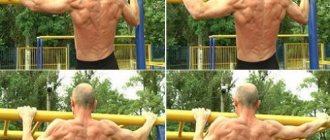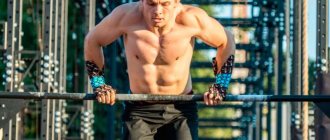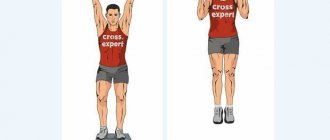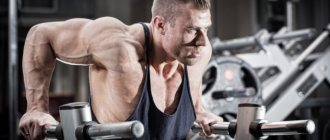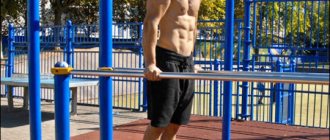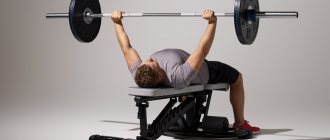Competent technique for performing the exercise and important nuances. How can you shift the load to the pectoral muscles or triceps. Every athlete (no matter whether he is a beginner or a professional in the world of sports) knows about this option for working out muscles, such as push-ups. With their help, it is possible to work the triceps, develop the anterior delta, work the pectoral muscle and stretch it efficiently. However, not everyone knows what the correct technique should be. The result is low efficiency of the training process and even injury.
Advantages
Why is it so useful to do push-ups on uneven bars? The following advantages are worth highlighting:
- Rapid development of the torso. During push-ups, the upper body is involved in the work - the lower pectoral muscles (when bending forward), triceps and shoulders receive the load. An interesting fact is that the lower part of the chest works weakly even when performing regular push-ups or a classic bench press.
- Working out the triceps and anterior deltoids. As practice shows, this exercise is an opportunity to qualitatively develop the shoulder girdle.
- Changing the load on different muscle groups depending on the angles of the body. So, when bending the torso forward, the lower pecs are worked out. If you do the exercise vertically, the triceps are more loaded.
The influence of grip width on muscle development
The distance between the palms when performing parallel bars training determines which muscles are pumped first. With a neutral grip (palms facing you) and a distance between the hands equal to shoulder width, the chest and triceps muscles are activated. This grip is preferable for beginner athletes. When performing the exercise, the entire muscle mass receives the load evenly.
A narrower grip and positioning of the elbows along the body gives emphasis to the triceps. To increase the load, you can use a pronated grip - palms away from you, arms as if turned out. A shoulder-width grip, half-bent legs and forward bend are a direct way to work the pectoral muscles. When working with a wide grip, you need to be careful, as there is a high risk of stretching the joint capsule.
The optimal width of the parallel bars should correspond to the width of the shoulders; a narrower grip will redistribute the entire load on the triceps muscle and triceps, a wide grip will load the pectoral muscles, and leave the rest idle.
With a neutral grip, which is recommended for beginners, the entire muscle mass receives the load evenly
Grip wider than shoulder width, bend your legs and bend forward - a direct way to work the pectoral muscles
A narrower grip and position of the elbows along the torso give emphasis to the triceps
To increase the load, you can use a pronated grip
General provisions
Despite its apparent simplicity, dips on parallel bars require knowledge of the rules and strict adherence to them. The following points are worth highlighting here:
- Place your wrists vertically and keep them level with the elbow joint. A normal grip is considered to be when the hands are slightly wider than the shoulders.
- Keep your elbows close to your body throughout the exercise. In the top position, they should be straightened completely only if you are focusing on the triceps. If you have sufficient flexibility, you should lower yourself to the limit of your joints.
- The shoulders should not move during the approach (no oscillatory movements). Otherwise, the risk of injury increases and efficiency decreases.
- Watch your spine - straighten it into a “string”. Thanks to this body position, the effectiveness of exercise increases.
- Try to tense your core (abs) muscles. The corset should be tight throughout the entire exercise. Thanks to this, it is possible to stabilize and hold the back in one position.
- It is forbidden to spread your legs (they must be pressed together or crossed). Tighten your hips and gluteal muscles, pull your toes back.
- Pay attention to your breathing. Air is released during ascent and gained as the body descends .
Dips: what muscles work?
During push-ups on the uneven bars, the shoulder and elbow joints are used, which means that the exercise is a basic one.
Accordingly, many muscles work, some of which bear the main load, and some play the role of auxiliary.
Target groups for performing the exercise:
- pectoralis major muscle;
- triceps brachii or triceps.
When working the triceps, the main load falls on the long head, which actively works as an extensor.
The following muscles stabilize the body, acting as assistants:
- shoulder blades – pectoralis minor, serrated, lower part of trapezius;
- Shoulders are rotators.
Also, when performing the movement, the abdominal and buttock muscles work.
From a biomechanical point of view, dips on the uneven bars represent flexion/extension/adduction/abduction of the elbow and shoulder joints, as well as the scapulothoracic joint.
Technology is the basis of success
Push-ups on parallel bars are performed using the following technique:
- to start the exercise from the bottom point . It is worth jumping onto the uneven bars and straightening your arms (this position is considered the starting position).
- Bend your torso forward (if you are working the lower pectoral muscles) and begin to lower yourself between the bars, bending your arms at the elbow joints. To activate your chest muscles, you should go as low as possible. If you “hang” at the midpoint and keep your body vertical, then the triceps receive the greatest load. At the end point, the chest should rise slightly above the projectile, and the hand should be at armpit level. You should not do deep descents from the very first workout (this is fraught with herbs). The body should be prepared gradually. In addition, you should not put additional weights on yourself until the muscles are sufficiently strengthened.
- At the bottom point, pause for 1-2 seconds , after which the torso rises to the top position. Please note that when working on the pecs, a slight extension of the elbows to the sides is mandatory. In addition, you should keep your body in an inclined position throughout the exercise. To switch the load to the triceps, keep your body vertical and press your elbow joints towards your body. It is worth considering here that the triceps are weaker than the chest, so dips on the uneven bars in this version should be performed in fewer repetitions or with less weight.
- The climb to the top point should be done slowly (in the absence of proper experience). You also need to lower yourself under control.
- Perform as many repetitions as your muscles can handle. When lifting is no longer possible, lower yourself and try again to rise on your hands. Even partial repetitions are effective and help stretch the chest. If the triceps get tired, you can move on to negative repetitions.
- If there is not enough experience in performing and the muscles are not able to even lift the body several times, then you should use a special exercise machine or place a chair under the parallel bars. In this case, the exercise is performed with the legs connected.
But there is a way out: push-ups!
Yes, this is a very simple and quick way to get yourself in order. Push-ups develop most of the muscles in the arms, back and chest. When repeated regularly, it gives not only relief, but also muscle mass.
We recommend reading: How to avoid gaining excess weight during the holidays
This site is constantly updated with simple but effective training programs. Push-ups are a simple but very effective exercise tool. By following the programs you will develop most of the muscles in your arms and back. You will perfectly train the muscles of the wings and chest.
Main mistakes
As you can see, push-ups on the uneven bars are a fairly simple exercise, the technique of which determines which muscle groups will be worked to a greater extent. But this does not prevent beginners and experienced athletes from making serious mistakes when performing. Among them:
- Errors in grip. It is often believed that a wide grip increases the load on the lower chest. But that's not true. Practice has shown that a medium grip is more effective when the hands are slightly wider than the shoulders . In this situation, the muscles are better loaded and less susceptible to injury.
- Incorrect inhalation and exhalation technique. Take in air before lowering to the bottom. The lungs should be filled for a full cycle of descent and 10-20% of ascent.
- Haste in execution. Another common mistake is doing push-ups in jerks. In such a situation, the muscles do not receive sufficient load for development. In addition, the risk of injury increases (especially if the joints are not warmed up). The process of lowering and raising should take an average of 2-2.5 seconds. After completely lowering, you should not immediately “jump” up - you should make a short delay. But this does not mean that the body is allowed to relax at the lowest point - the muscles must be tense.
- Insufficient warm-up. You cannot do the exercise if the body is not sufficiently warmed up. Initially, you should stretch your upper body. So, you should start with stretching, and then move on to regular push-ups and preparatory training on the uneven bars (at 0.5 full amplitude).
Execution options
Push-ups on the horizontal bar and parallel bars are a basic exercise, so the muscles receive a serious load. Such movements allow you to create a beautiful chest relief, improve posture, and straighten the shoulder girdle. To train with maximum effect, you must adhere to a certain technique.
On the pectoral muscles
The exercise must be performed in the following sequence:
- Starting position - emphasis on the bars with straight arms, the body is fixed vertically, the legs are torn off the ground, the load is distributed proportionally. Place your hands slightly wider than your shoulders. It is better to cross your legs at the ankles.
- As you inhale, slowly lower yourself to the position where your shoulders are below your elbows. You need to carefully monitor your elbows, they should be widely spaced. The body is slightly tilted forward, the chin is pressed to the chest - this will allow the lower section to be included in the work. The angle at the elbows should be 90 degrees or slightly less. Climb up only after you feel a muscle stretch.
- As you exhale, gradually rise up to the starting point. Leave your arms slightly bent to avoid damage to the elbow joint. Try not to rock your body, keep your buttocks and abs tense. Without fixing for a long time at the top point, go down again. The greater the torso tilt, the wider the grip and the more the elbows are spread, the more the pectoral muscles are loaded.
Typical mistakes when performing a training complex are to do the exercise too quickly and jerkily, this will not allow you to pump up the muscles well enough and is fraught with injury.
For triceps
In this exercise, the technique is slightly different:
- Starting position - emphasis on the horizontal bar with straight arms, the body is in an upright position and as tense as possible, the gaze is directed forward, the chin is looking at the floor. The grip is at shoulder level or slightly narrower, the position of the legs is as convenient for the athlete (do not bend at the knees).
- As you inhale, gradually lower yourself down, pointing your elbows back along your body. At the lowest point, the bend angle of the elbows should be 90 degrees.
- As you exhale, smoothly rise up to the starting point. The work of the triceps is affected by the vertical position of the body, the width of the grip and the direction of the elbows. If the distance between the palms is wider than the shoulders, then the load will inevitably transfer to the chest. It is better to fixate for 2-3 seconds at the lowest and highest points - this will make the training more effective.
Typical mistakes of athletes are going down too deep, strong movements of the torso and legs, and performing the exercise quickly.
After mastering the basic level, when you can effortlessly do 15–20 repetitions in one approach, you can master weighted bar push-ups. The weight can be an ordinary backpack filled with water bottles. It is better to increase the weight gradually, focusing on your feelings and working muscles.
Particular attention should be paid when jumping from the horizontal bar. When jumping sharply, there is a high probability of twisting your legs. It is better to get off the machine slowly and smoothly.
Results
In conclusion, it is worth highlighting a number of rules that the athlete must take into account:
- After strengthening the muscles and achieving maximum amplitude, you should move on to working with weights. Thanks to the additional weight, it is possible to reduce repetitions to 8-10 and accelerate muscle growth. The main thing is to be careful when lifting your body to the top position. Sharpness in performing exercises with weights is possible only after several months of training.
- When working, try to lower slowly (in 2-3 counts) and rise quickly.
- Slow lowering ensures chest stretching and microtrauma of muscle fibers, which subsequently promotes muscle growth.
Dips program
For dips, a program of 3..5 working approaches of 6..12 repetitions each is usually suggested.
But what to do if an athlete is just starting to master the apparatus, and his own weight does not allow him to carry out the classic training program?
In this case, you can use an ascending/descending load pattern in each approach (such as a “pyramid”), which will allow, over time, to increase the absolute number of repetitions. With approximately 5 approaches, it looks like this:
- day: 1 1 2 1 1
- day: 1 1 3 2 1
- day: 1 2 4 3 2
- day: 2 3 4 3 2
- day: 2 3 5 4 2 etc.
Those. we try regularly, little by little, but increase the load until we can perform the required number of repetitions.
This approach allows you to increase strength and muscle endurance, preparing the body for mass work.
It can be started when the athlete can confidently perform 6 repetitions in each approach, controlling the speed of movement in the active and negative phases.
After reaching 12...15 push-ups in each of the five repetitions, it makes sense to think about using weights to progress loads and grow the triceps.
By the way, I told this trick with the “pyramid” to the participants of the “Extreme Mass Gain” course.
In this course you will learn a lot of practical things and are guaranteed to gain those treasured kilograms under my guidance.
Will training on the horizontal bar and uneven bars help you get pumped up?
As soon as you leave the house, a horizontal bar with parallel bars will certainly be found on the nearest sports ground or in the school yard. There are analogues in gyms.
“The undoubted advantages of training on parallel bars and the horizontal bar are their accessibility and the absence of the need to carry barbells, dumbbells and plates to perform exercises,” says X- gyms in Russia. “ With the correct training process using horizontal bars and parallel bars, you can gain muscle mass, lose excess weight and make your abs perfect.”
Please note that to gain muscle mass, not only regular training is important, but also nutrition with a calorie surplus due to protein with a variety of amino acids. “But you shouldn’t expect too large volumes,” explains Mikhail Vysochansky, “to get huge muscles you need to practice basic exercises in the gym (deadlifts and squats).”
Common mistakes when doing the exercise
Of course, at first glance it may seem that the exercises are quite simple, and it is simply impossible to make a mistake. However, dips can both benefit the body if the technique is used correctly, and cause harm if mistakes are made.
The most common errors are related to the position of the back and elbows or the inertia of the body.
But there are still other errors when working with a projectile:
- Breathing technique. Before lowering your body down, you need to take a breath, otherwise you can injure your chest muscles.
- Incorrect grip – wide or with a bent wrist. The most optimal is considered to be an average grip of hands at a distance of shoulder width.
- High speed push-ups. Sudden intermittent movements can harm the muscles. The delay for each lowering and raising should be 2 seconds. You need to keep the tension at the lowest point.
- Sudden weight gain. You need to add load gradually so as not to stress both the muscular and cardiovascular systems. The body must gradually, getting used to the load, strengthen its ability to build and strengthen muscle mass.
- Poor warm-up. How well you perform push-ups on the uneven bars depends on how conscientiously the warm-up is done. Poor warm-up often causes injuries. The warm-up can include stretching, push-ups and rotational movements of the joints.
